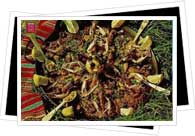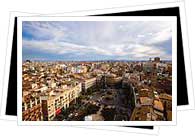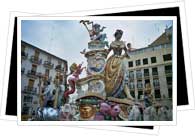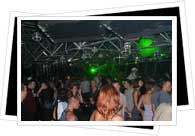Introduction to Valencia, Spain
 Mix together hearty amounts of the non-stop energy of Madrid, the cosmopolitan vibe of Barcelona, the friendly nature of Sevilla and a dash of laid-back, beach-town comfort, and you have the recipe for Valencia. Traditionally, sunny Valencia is known to be the home of paella, the Holy Grail - they swear it's the real thing - and the legendary El Cid, although the rejuvenating cultural renaissance that the city has experienced in recent years has given the city a brand new edge.
Mix together hearty amounts of the non-stop energy of Madrid, the cosmopolitan vibe of Barcelona, the friendly nature of Sevilla and a dash of laid-back, beach-town comfort, and you have the recipe for Valencia. Traditionally, sunny Valencia is known to be the home of paella, the Holy Grail - they swear it's the real thing - and the legendary El Cid, although the rejuvenating cultural renaissance that the city has experienced in recent years has given the city a brand new edge.
 Located halfway up Spain's Mediterranean coastline and surrounded by La Huerta, Europe's most fertile slab of land, Valencia was destined to be one of Spain's stand-out cities, a destiny demonstrated by the civilizations throughout its history after its sea commerce and agricultural wealth. Today, with a population totaling just a hair beneath 800,000, Valencia comes in as Spain's third largest city and, as the capital of the aptly-named Comunidad Valenciana, certainly one of the most significant.
Located halfway up Spain's Mediterranean coastline and surrounded by La Huerta, Europe's most fertile slab of land, Valencia was destined to be one of Spain's stand-out cities, a destiny demonstrated by the civilizations throughout its history after its sea commerce and agricultural wealth. Today, with a population totaling just a hair beneath 800,000, Valencia comes in as Spain's third largest city and, as the capital of the aptly-named Comunidad Valenciana, certainly one of the most significant.
Today, it has the culture, the energy, the sophistication, the shopping and the nightlife - particularly in El Carmen, around the University and along the beach front - expected of a major metropolis. Yet with the influx of attention, tourism and new "stuff," Valencia is one of the few Mediterranean cities that retains its regional character and pride. Along with the revival of the Valencian language, following the 1975 death of Spain's ultra-nationalist dictator Francisco Franco, Valencianos love being Valencianos and are proud to show it through age-old traditions, music, dances, food recipes, artisan crafts and festivals.
 Speaking of festivals, Valencia is home to some of Spain's most off-beat, quirky and riotous fiestas, like the tomato-hurling La Tomatina, the flower-pelting Battle of the Flowers, and even a festival dedicated solely to fireworks. Leading the pack, however, is definitely Las Fallas, a veritable pyrotechnic orgy of fireworks, blazing papier-machè towers and non-stop window-rattling firecracker explosions only proving the fun-loving and, at times, quite rambunctious nature of the Valencian people. For more proof just head to a Valencia CF football game. As one of Spain's elite teams, the team has a loyal fan base and game night atmosphere is out of this world.
Speaking of festivals, Valencia is home to some of Spain's most off-beat, quirky and riotous fiestas, like the tomato-hurling La Tomatina, the flower-pelting Battle of the Flowers, and even a festival dedicated solely to fireworks. Leading the pack, however, is definitely Las Fallas, a veritable pyrotechnic orgy of fireworks, blazing papier-machè towers and non-stop window-rattling firecracker explosions only proving the fun-loving and, at times, quite rambunctious nature of the Valencian people. For more proof just head to a Valencia CF football game. As one of Spain's elite teams, the team has a loyal fan base and game night atmosphere is out of this world.
 Not only is Valencia constantly alive with fireworks and music, but it's also visually stunning. Along with blue Mediterranean Sea, the golden beaches and lush green parks and gardens, the city of Valencia is essentially a microcosm of Spanish architecture. Ranging from the dark Visigoth Crypt of the Prison of Saint Vicente the Martyr to the Gothic Silk Exchange, the Mercado Central - an aesthetically stunning Moderniste masterpiece doubling as one of Europe's largest covered markets - and everything in between, the city's architectural wealth is without rival.
Not only is Valencia constantly alive with fireworks and music, but it's also visually stunning. Along with blue Mediterranean Sea, the golden beaches and lush green parks and gardens, the city of Valencia is essentially a microcosm of Spanish architecture. Ranging from the dark Visigoth Crypt of the Prison of Saint Vicente the Martyr to the Gothic Silk Exchange, the Mercado Central - an aesthetically stunning Moderniste masterpiece doubling as one of Europe's largest covered markets - and everything in between, the city's architectural wealth is without rival.
Aside from the architectural affluency, a walk through Valencia will lead you though a culture-soaked city with over 40 outstanding museums, an eclectic collection of bars and restaurants, lively markets, theaters, and an accessible historical quarter. North of the Ayuntamiento and Cathedral "barrios" (neighborhoods), you'll enter El Carmen, the oldest part of Valencia's historical quarter- easily the most interesting and atmospheric zone to amble through. With narrow streets dating back centuries, a medieval fortification or two and all sorts of restaurants, cafés and bars, it's one of the hubs of Valencia's nightlife and certainly provides some top-notch people-watching.
How does a city become a so-called "renaissance city?" In Valencia's case, by polishing up the old and incorporating the new. Valencia's government seeks to boost the city's tourism industry and attract the international attention that it deserves. Some new projects include a total revamping of Valencia's historical quarter, the naming of Valencia as the host of 2007's America's Cup yachting regatta and the construction of the ultra-modern City of Arts and Sciences. The collection of brilliantly white, futuristic structures is now Spain's second most visited attraction and is - with a multi-function arts and music performance center, Europe's largest aquarium, an interactive science museum, a planetarium, an IMAX theater and much more - without a doubt the first of its kind in Europe.
